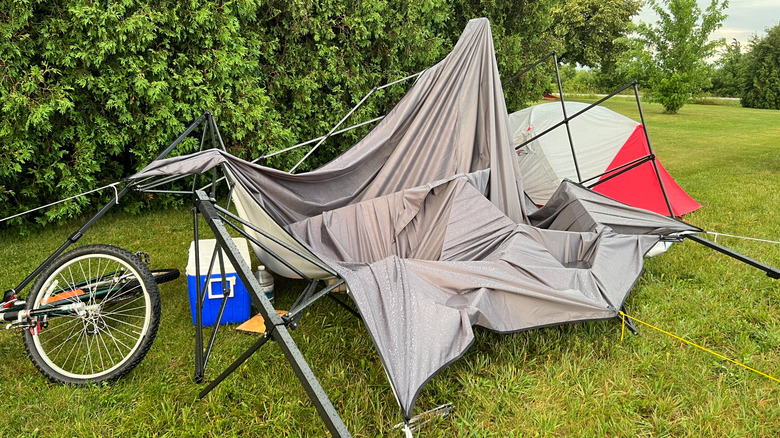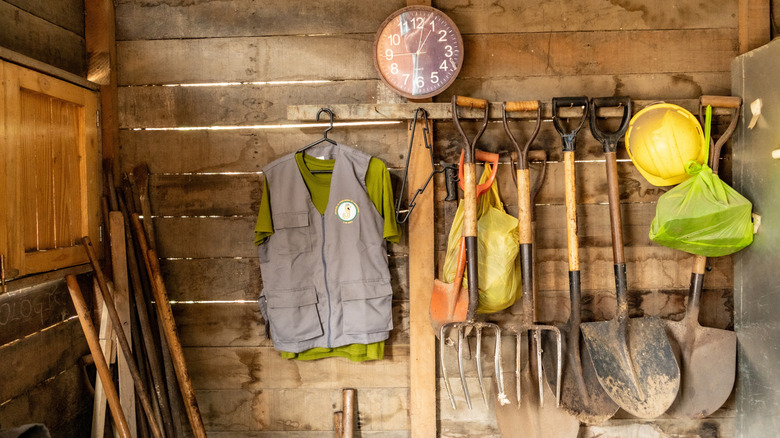Clever Ways To Repurpose Tent Poles In Your Yard And Garden
A tent is a must-have for many, from those off on a summer camping trip to ice fishing enthusiasts who need a warm shelter. Even if your tent is designed to handle decades of wind, rain, and sun, it's bound to wear out at some point. When that happens, figuring out what to do with it can be challenging. For starters, most of its components aren't fit for the recycling bin. Some outdoor suppliers, including Mountain Hardwear and Big Agnes, have repair initiatives to help keep broken gear out of landfills. Others, such as Green Guru, upcycle old tents to create new products. If programs like these aren't an option, or if you'd rather go another route, consider repurposing tent parts in your yard and garden. Tent poles are especially versatile, and they may have lots of life left when the rest of your tent is shot.
Before repurposing your old tent poles, wash them and assess their condition. Detach them from the rest of the tent so you can carefully inspect them for structural problems. Proceed with caution if you find rust or jagged spots. Your sturdiest, least damaged poles are likely to have the most uses, though broken poles aren't necessarily a lost cause. For instance, scratched and dented tent poles can be used as backup fishing poles if your usual equipment calls it quits. Just tie a hook and line on one end and you're good to go. If they're the correct length and free of sharp edges, imperfect poles can also work as hiking poles or the frame of a kite.
Reusing tent poles to support plants
Tomatoes (which are also fuss-free plants excellent for beginner gardeners) benefit from staking, and tent poles happen to make excellent stakes. Instead of buying new cages for your tomato plants, use old tent poles to keep them from flopping onto the ground, where they're vulnerable to fungus, diseases, and hungry critters. Stakes that are roughly 8 feet high work well for many types of tomatoes, particularly tall, vining indeterminate varieties like Better Boy and Brandywine. To get started, push a tent pole about a foot into the soil beside a tomato plant. When the plant is several inches tall, tether it to the pole with twine or strips of cloth.
You can also construct homemade tomato cages with tent poles. Bamboo poles work especially well for this task. Pour a few inches of sand into a 5-gallon bucket and place three poles along its edges, equal distances apart. Then put thin, horizontal support bars between the vertical poles and attach them with cable ties. Black ties like those in the Anoson 400-pack of black UV-resistant cable zip ties in assorted sizes tend to withstand sun and rain. For a demonstration of this process, see a tomato cage DIY video by YouTuber Ted's Backyard.
Vining cucumbers and squash love growing on trellises. You can make a garden trellis with an old hose, tent poles, or both. Try fashioning a frame from old tent poles and weaving hose pieces into it, forming a lattice. Attach the hose to the frame with black cable ties. Planning to grow runner beans? You can tie together the tops of several tent poles to form cone-shaped trellises that the plants will climb like jungle gyms.
Turning tent poles into storage, decor, and more
You'll find plenty more uses for tent poles if you put on your thinking cap. Brainstorming other objects that contain rods and posts is a good first step. See if you can reuse tent poles as hanging bars for hoses and tools in your garden shed. These poles also make durable rods for clothing hangers, which can help you store coveralls, drop cloths, tarps, and similar items that can live in the garage. Or upcycle two tent poles into a portable clothesline by joining them with a weatherproof string. Since most tent poles are made for outdoor use, a clothesline made from them can probably handle your patio or your laundry room. It's also a handy tool for airing out swimsuits, towels, and other wet items when camping.
In the garden, try turning tent poles and wire mesh into fencing to keep rabbits away from your lettuce and spinach. If you have leftover poles from your fence project, use them to display small garden flags. A welcome flag like the Ekorest two-sided Welcome mushroom garden flag can help guests feel at home among your veggies and flowers, while a warning flag like the Happy Cow Lawn Decor two-sided Go Away gnome garden flag can remind those pesky rabbits that your garden's off limits.

